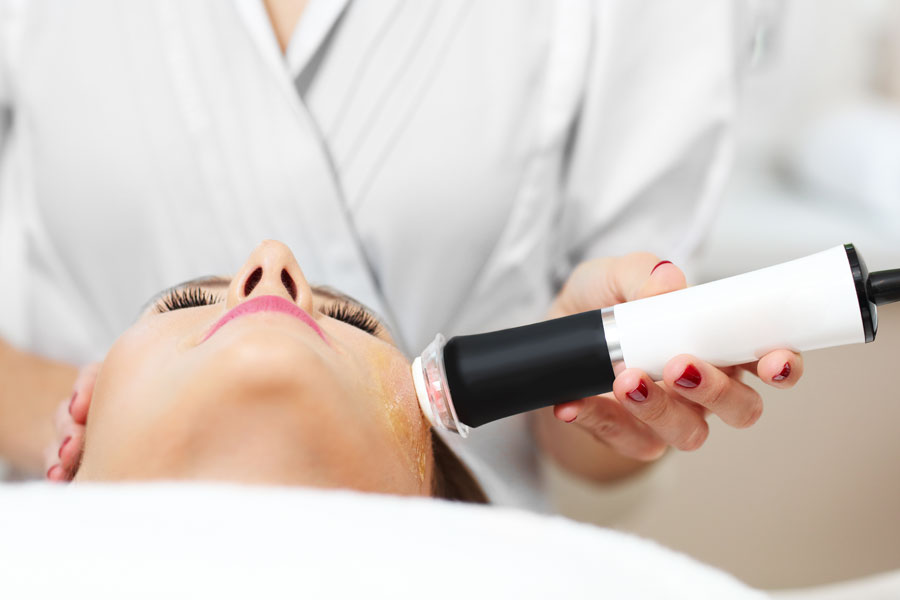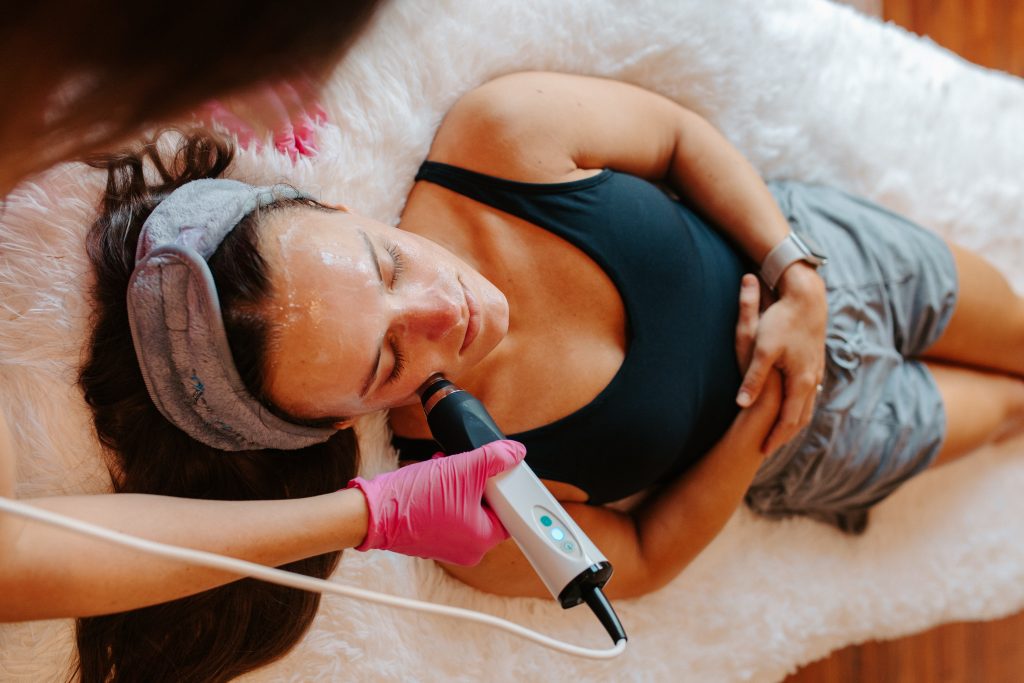How to Choose Between Microneedling vs. Chemical Peels
Written by: Erin Sevigny
If you’re on a quest for radiant, youthful-looking skin, chances are you’ve heard of two popular skincare treatments: microneedling and chemical peels. These transformative procedures have been making waves in the beauty and skincare industry, offering gorgeous results for those looking to rejuvenate their skin.
Both of these treatments offer effective ways to address common skin concerns, but they’re two completely different procedures that address different skin concerns. So how do you choose between microneedling vs. chemical peels?
At Franklin Skin Studio, we understand the importance of informed choices when it comes to your skincare journey. In this blog, we’ll do a deep dive into the world of microneedling and chemical peels to help you decide which treatment is right for you.
What is Microneedling?
Don’t let the name of this treatment fool you — it’s a gentle and effective way to reveal fresh, radiant skin! Microneedling, also known as collagen induction therapy, is a minimally invasive cosmetic procedure that uses a device with fine needles to create controlled micro-injuries on the skin’s surface. While this sounds extreme, these tiny, controlled punctures stimulate the body’s natural healing process, leading to the production of collagen and elastin.
The Microneedling Process
Here’s how it works:
- Preparation: Before the procedure, a numbing cream or gel is applied to the treatment area to minimize discomfort.
- Microneedling: A specialized microneedling device, often in the form of a pen or roller, is used to create thousands of tiny, evenly-spaced punctures in the skin. These punctures are very shallow and reach only the upper layers of the skin, making it a non-ablative procedure (meaning it does not remove the top layer of skin).
- Healing Response: The micro-injuries trigger the body’s natural wound-healing response. As the skin heals, it produces new collagen and elastin fibers, which contribute to improved skin texture, reduced wrinkles, and a more even complexion.
- Post-Treatment: After the procedure, there may be some redness and mild swelling, similar to a sunburn, which typically subsides within a few days. In some cases, you may experience mild peeling after microneedling.
Benefits of Microneedling
Microneedling isn’t touted as one of the most popular treatments for no reason. Here’s how microneedling can help you achieve your skincare goals:
- Collagen Production: Microneedling stimulates the production of collagen and elastin, two essential proteins that give skin its firmness and elasticity. As the skin heals from the micro-injuries created during the procedure, it naturally increases collagen production. This leads to firmer, more youthful-looking skin with improved texture and elasticity.
- Reduction of Fine Lines and Wrinkles: Microneedling is particularly effective at reducing the appearance of fine lines and wrinkles. By promoting collagen growth, microneedling for wrinkles helps plump up the skin and smooth out lines and creases like crow’s feet, smile lines, and forehead wrinkles.
- Acne Scar Improvement: Microneedling is a popular treatment for minimizing the appearance of scars, including acne scars. The controlled micro-injuries help break down scar tissue and promote the growth of new, healthier skin cells, leading to smoother and more even skin.
- Treatment of Hyperpigmentation: Microneedling can help fade dark spots, sunspots, and other forms of hyperpigmentation by promoting an even distribution of melanin in the skin. This can result in a more uniform and radiant complexion.
- Reduced Pore Size: Enlarged pores can make the skin appear rough and uneven. Microneedling can help shrink the size of pores, giving the skin a smoother and more refined texture.
- Improved Skin Texture: Microneedling enhances overall skin texture by promoting the growth of new skin cells and collagen. This can be especially beneficial for individuals with uneven skin texture.
In addition to dramatic results, microneedling requires relatively little downtime and is suitable for various skin types.
What is a Chemical Peel?
A chemical peel is a cosmetic procedure that involves the application of a chemical solution to the skin’s surface. This solution causes the skin to exfoliate and eventually peel off, leading to the regeneration of new skin cells. Chemical peeling is used to improve the skin’s appearance, texture, and tone and can be tailored to different depths, depending on the specific skin concerns and goals of the individual.
The Chemical Peel Process
Here’s a breakdown of what happens during a chemical peel:
- Chemical Solution: A chemical solution is applied to the skin. The type and strength of the solution used depend on the depth of the peel and the desired outcomes. There are three main types of chemical peels:
- Superficial (Light) Peels: These use mild acids, such as alpha hydroxy acids (AHAs) or beta hydroxy acids (BHAs), to exfoliate the outermost layer of the skin (epidermis). Superficial peels are often used to improve skin texture and treat minor discoloration.
- Medium Peels: Medium-depth peels use stronger acids, such as glycolic acid or trichloroacetic acid (TCA), to target the middle layer of skin (dermis). These peels can address more pronounced wrinkles, fine lines, and moderate skin discoloration.
- Deep Peels: Deep peels penetrate into the deeper layers of the skin and use potent acids like phenol. This is the best face peel for more severe skin concerns, such as deep wrinkles and scars.
- Exfoliation and Peeling: After the chemical solution is applied, the skin will begin to peel and shed its top layer. This process removes damaged or aged skin cells, revealing newer, healthier skin underneath.
- Post-Treatment Care: It’s best to avoid sun exposure, use gentle skincare products, and apply sunscreen to protect the newly revealed skin.
Benefits of a Chemical Peel
You can choose a chemical peel for acne scars, wrinkles, and more! Let’s look at some of the benefits offered by chemical peels:
- Exfoliation: Chemical peels exfoliate the skin by removing the outermost layer of dead skin cells. This exfoliation reveals newer, healthier skin beneath, leading to a smoother, more youthful complexion.
- Improved Skin Texture: Chemical peels can significantly improve the texture of the skin, making it feel softer and more refined. This is particularly beneficial for individuals with rough or uneven skin.
- Reduced Wrinkles and Fine Lines: The best chemical peel for wrinkles is typically the medium or deep peel because these stimulate collagen production in the skin. Collagen is a protein that provides structural support to the skin, and an increase in its production can lead to a reduction in the appearance of wrinkles and fine lines.
- Acne Treatment: Chemical peels can help treat acne by unclogging pores, reducing inflammation, and preventing new breakouts. They are often used to address both active acne and acne scars. Note that the best chemical peel for acne scars isn’t necessarily the most aggressive one — for some people, the superficial peel is more than enough.
- Fading Hyperpigmentation: Chemical peels can be effective in reducing the appearance of hyperpigmentation, including age spots, sunspots, and melasma. The exfoliation and removal of pigmented skin cells can lead to a more even skin tone. Be sure to discuss with our aesthetician which is the best chemical peel for hyperpigmentation for your needs.
- Youthful Radiance: Chemical peels can give the skin a youthful glow by removing dull and dead skin cells and revealing fresher, more vibrant skin underneath.
- Minimized Enlarged Pores: Enlarged pores can make the skin appear rough and uneven. Chemical peels can help shrink the size of pores, giving the skin a smoother and more refined texture.
Our skilled aestheticians will discuss your skincare needs and help you determine which type of chemical peel is best for you.
Microneedling vs. Chemical Peel: Key Differences
Now that you know a bit more about each one, let’s compare these two popular treatments.
Treatment Process
Microneedling: This treatment involves the use of a device with fine needles to create controlled micro-injuries in the skin’s surface. It triggers the body’s natural healing response, promoting collagen and elastin production, which leads to improved skin texture and firmness.
Chemical Peel: Chemical peels use a chemical solution to exfoliate and remove the outermost layer of skin. This exfoliation reveals fresher skin underneath and stimulates skin regeneration.
Depth of Treatment
Microneedling: The depth of microneedling can be adjusted, allowing for customization based on the individual’s skin concerns. It primarily targets the upper layers of the skin.
Chemical Peel: Chemical peels can be tailored to different depths (superficial, medium, or deep). The depth of the peel depends on the type and strength of the chemical solution used, with deeper peels penetrating further into the skin.
Targeted Skin Concerns
Microneedling: Microneedling is effective for addressing concerns such as fine lines and wrinkles, acne scars, enlarged pores, and overall skin texture and firmness.
Chemical Peel: Chemical peels are versatile and can target issues like sun damage, hyperpigmentation, uneven skin tone, acne, and fine lines. The depth of the peel selected influences which concerns it can address effectively.
Downtime
Microneedling: Generally, microneedling has minimal downtime. There may be some redness and mild swelling immediately after the procedure, but these effects typically subside within a few days.
Chemical Peel: The downtime varies depending on the depth of the peel. Superficial peels may have little to no downtime, while medium and deep peels may require several days to weeks for recovery, including peeling and redness.
Suitability for Skin Types
Microneedling: Microneedling is generally suitable for various skin types and tones, with a lower risk of causing changes in pigmentation.
Chemical Peel: The risk of post-inflammatory hyperpigmentation or hypopigmentation can be a concern for individuals with darker skin tones, especially with deeper chemical peels.
Microneedling vs. Chemical Peel: Which is Right for Me?
So sure, this was all helpful information — but what does that mean for you? Choosing between microneedling and a chemical peel depends on your specific skin concerns, preferences, and factors such as skin type.
Here are some general guidelines to help you determine which treatment might be right for you:
Choose Microneedling If:
- You Want to Target Wrinkles and Fine Lines: If your main goal is targeting signs of aging, choose microneedling. Wrinkles and fine lines are drastically reduced thanks to the production of collagen and elastin.
- You Have Acne Scars: Microneedling can significantly improve the texture of the skin and diminish the appearance of acne scars. It can help with both active acne and residual scarring.
- You Prefer Minimal Downtime: Microneedling typically has shorter downtime compared to medium and deep chemical peels. You can expect some redness and swelling, but it usually subsides within a few days.
- You Have Sensitive Skin: Microneedling is generally well-tolerated by individuals with sensitive skin, as it is less likely to cause post-inflammatory hyperpigmentation than some chemical peels.
- You’re Looking for Collagen Stimulation: Microneedling promotes collagen and elastin production, which can lead to long-term improvements in skin texture and firmness.
Choose a Chemical Peel If:
- You Have Multiple Skin Concerns: Chemical peels are versatile and can address a wide range of skin issues, including sun damage, hyperpigmentation, acne, and uneven skin tone. They can also be customized to your specific concerns.
- You Want to Tackle Sun Damage: Chemical peels are highly effective at treating sun-damaged skin, including sunspots, age spots, and uneven pigmentation.
- You Prefer a One-Time Treatment: While some chemical peels may require multiple sessions, superficial peels can provide noticeable results with a single treatment.
- You’re Fine with Downtime: If you’re willing to endure a longer recovery period, especially for medium or deep peels, chemical peels may be suitable. These peels can offer more dramatic results but come with increased downtime.
- You Prefer a Faster Treatment: Chemical peels can be completed relatively quickly, making them a convenient option for those with busy schedules.
Book Your Session at Franklin Skin Studio
Are you ready to transform your skin and unveil a radiant, more youthful you? At Franklin Skin Studio, we’re here to guide you on your journey to achieving your skincare goals, whether it’s through the rejuvenating power of microneedling or the transformative effects of a chemical peel.
Our experienced team of skincare professionals understands that each individual is unique, and so are their skincare needs. We offer personalized consultations to assess your skin, discuss your concerns, and tailor a treatment plan that suits you best.
Start your journey towards healthier, more beautiful skin. Book your microneedling or chemical peel in Franklin, TN today!


